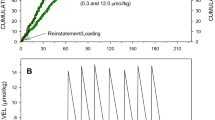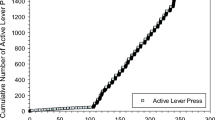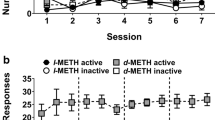Abstract
Intravenous self-administration of GBR 12909, an indirect dopamine agonist, was examined on a Fixed Ratio (FR 1) and a Progressive Ratio (PR) schedule of reinforcement in rats. Subjects were first trained to self-administer cocaine (1.5 mg/kg/inj) during daily 5 h sessions, after which GBR 12909 (0.187–1.5 mg/kg/inj) was substituted. On the FR 1 schedule, the inter-infusion interval for GBR 12909 self-administration was directly related to dose and was approximately three times longer than that established for equivalent doses of cocaine. Breaking points on the PR schedule were comparable for GBR 12909 and cocaine self-administration. The data indicate that, compared to cocaine, GBR 12909 has a longer duration of action and a similar reinforcing efficacy.
Similar content being viewed by others
References
Anderson PH (1989) The dopamine uptake inhibitor GBR 12909: selectivity and molecular mechanism of action. Eur J Pharmacol 166:493–504
Baldo BA, Kelley AE (1991) Cross-sensitization between cocaine and GBR 12909, a dopamine uptake inhibitor. Brain Res Bull 27:105–108
Bedford JA, Bailey LP, Wilson MC (1978) Cocaine reinforced progressive ratio performance in the rhesus monkey. Pharmacol Biochem Behav 9:631–638
Bergman J, Madras BK, Johnson SE, Spealman RD (1989) Effects of cocaine and related drugs in nonhuman primates. III. Self-administration by squirrel monkeys. J Pharmacol Exp Ther 251:150–155
Britton DR, Curzon P, MacKenzie RG, Kebabian JW, Williams JEG, Kerkman D (1991) Evidence for involvement of both D1 and D2 receptors in maintaining cocaine self-administration. Pharmacol Biochem Behav 39:911–915
Cunningham KA, Callahan PM (1991) Monoamine reuptake inhibitors enhance the discriminative state induced by cocaine in the rat. Psychopharmacology 104:177–180
Griffiths RR, Findley JD, Brady JV, Gutcher K, Robinson WW (1975) Comparison of progressive-ratio performance maintained by cocaine, methylphenidate and secobarbitol. Psychopharmacology 43:81–83
Griffiths RR, Brady JV, Snell JD (1978) Progressive-ratio performance maintained by drug infusions: comparison of cocaine, diethylpropion, chlorphentermine, and fenfluramine. Psychopharmacology 56:5–13
Griffiths RR, Bradford LD, Brady JV (1979) Progressive ratio and fixed ratio schedules of cocaine-maintained responding in baboons. Psychopharmacology 65:125–136
Heikkila RE, Manzino L (1984) Behavioral properties of GBR 12909, GBR 13069 and GBR 13098: Specific inhibitors of dopamine uptake. Eur J Pharmacol 103:241–248
Hoffmeister F (1979) Progressive-ratio performance in the rhesus monkey maintained by 3 opiate infusions. Psychopharmacology 62:181–186
Howell LL, Byrd LD (1991) Characterization of the effects of cocaine and GBR 12909, a dopamine uptake inhibitor, on behavior in the squirrel monkey. J Pharmacol exp Ther 258:178–185
Kelley AE, Lang CG (1988) A behavioral investigation of GBR 12909: effects on motor activity, fixed interval responding, and conditioned reinforcement. Soc Neurosci Abstr 14:662
Kelley AE, Lang CG (1989) Effects of GBR 12909, a selective dopamine uptake inhibitor, on motor activity and operant behavior in the rat. Eur J Pharmacol 167:385–395
Kleven MS, Anthony EW, Nielson EB, Woolverton WL (1988) Reinforcing and discriminative stimulus effects of GBR 12909 in rhesus monkeys. Soc Neurosci Abstr 14:305
Kuhar MJ, Ritz MC, Boja JW (1991) The dopamine hypothesis of the reinforcing properties of cocaine. TINS 14:299–302
Loh EA, Roberts DCS (1990) Break-points on a progressive ratio schedule reinforced by intravenous cocaine increase following depletion of forebrain serotonin. Psychopharmacology 101:262–266
Lyness WH, Friedle NM, Moore KE (1979) Destruction of dopaminergic nerve terminals in nucleus accumbens: effects ofd-amphetamine self-administration. Pharmacol Biochem Behav 11:553–556
Melia KF, Spealman RD (1991) Pharmacological characterization of the discriminative-stimulus effects of GBR 12909. J Pharmacol Exp Ther 258:626–632
Meloni R, Gale K (1991) Cocaine-induced turning behavior in rats with 6-hydroxydopamine lesions: effect of transplants of fetal substantia nigra. Eur J Pharmacol 209:113–117
Pettit HO, Justice JB Jr (1990) Dopamine in the nucleus accumbens during cocaine self-administration as studied by in vivo microdialysis. Pharmacol Biochem Behav 34:899–904
Pettit HO, Justice JB Jr (1991) Effect of dose on cocaine self-administration behavior and dopamine levels in the nucleus accumbens. Brain Res 539:94–102
Pettit HO, Ettenberg A, Bloom FE, Koob GF (1984) Destruction of dopamine in the nucleus accumbens selectively attenuates cocaine but not heroin self-administration in rats. Psychopharmacology 84:167–173
Risner ME, Cone EJ (1986) Intravenous self-administration of fencamfamine and cocaine by beagle dogs under fixed-ratio and progressive-ratio schedules of reinforcement. Drug Alcohol Depend 17:93–102
Risner ME, Goldberg SR (1983) A comparison of nicotine and cocaine self-administration in the dog: fixed ratio and progressive-ratio schedules of intravenous drug infusion. J Pharm Exp Ther 224:319–326
Risner ME, Silcox DL (1981) Psychostimulant self-administration by beagle dogs in a progressive-ratio paradigm. Psychopharmacology 75:25–30
Roberts DCS (1989) Breaking points on a progressive ratio schedule reinforced by intravenous apomorphine increase daily following 6-hydroxydopamine lesions of the nucleus accumbens. Pharmacol Biochem Behav 32:43–47
Roberts DCS, Goeders N (1989) Drug self-administration: experimental methods and determinants. In: Boulton AA, Baker GB, Greenshaw AJ (eds) Neuromethods, vol 13, Psychopharmacology. Humana Press, New Jersey, pp 349–398
Roberts DCS, Koob GF (1982) Disruption of cocaine self-administration following 6-hydroxydopamine lesions of the ventral tegmental area in rats. Pharmacol Biochem Behav 17:901–904
Roberts DCS, Richardson NR (1992) Self-administration of psychomotor stimulants using progressive ratio schedules. In: Wu P, Boulton A, Baker GB (eds) Animal models of drug addiction. Humana, New Jersey, p 1
Roberts DCS, Vickers GJ (1984) Atypical neuroleptics increase self-administration of cocaine: an evaluation of a behavioral screen for antipsychotic drug activity. Psychopharmacology 82:135–139
Roberts DCS, Koob GF, Klonoff P, Fibiger HC (1980) Extinction and recovery of cocaine self-administration following 6-hydroxydopamine lesions of the nucleus accumbens. Pharmacol Biochem Behav 12:781–787
Roberts DCS, Loh EA, Vickers GJ (1989) Self-administration of cocaine on a progressive ratio schedule in rats: dose-response relationship and effect of haloperidol pretreatment. Psychopharmacology 97:535–538
Rompré P-P, Bauco P (1990) GBR 12909 reverses the SCH 23390 inhibition of rewarding effects of brain stimulation. Eur J Pharmacol 182:181–184
Spyraki C, Fibiger HC (1981) Intravenous self-administration of nomifensine in rats: implications for abuse potential in humans. Science 212:1167–1168
Van der Zee P, Koger HS, Gootjes J, Hespe W (1980) Aryl 1,4-dialk(en)ylpiperazines as selective and very potent inhibitors of dopamine uptake. Eur J Med Chem 15:363–370
Wilson MC, Schuster CR (1976) Mazindol self-administration in the rhesus monkey. Pharmacol Biochem Behav 4:207
Witkin JM, Nichols DE, Terry P, Katz JL (1991) Behavioral effects of selective dopaminergic compounds in rats discriminating cocaine injections. J Pharmacol Exp Ther 257:706–713
Woolverton WL (1986) Effects of a D1 and D2 dopamine antagonist on the self-administration of cocaine and piribedil by rhesus monkeys. Pharmacol Biochem Behav 24:531–535
Woolverton WL, Virus RM (1989) The effects of a D1 and D2 dopamine antagonist on behavior maintained by cocaine or food. Pharmacol Biochem Behav 32:691–697
Yokel RA, Wise RA (1975) Increased lever pressing for amphetamine after pimozide in rats: implication for a dopamine theory of reward. Science 187:547–549
Author information
Authors and Affiliations
Rights and permissions
About this article
Cite this article
Roberts, D.C.S. Self-administration of GBR 12909 on a fixed ratio and progressive ratio schedule in rats. Psychopharmacology 111, 202–206 (1993). https://doi.org/10.1007/BF02245524
Received:
Revised:
Issue Date:
DOI: https://doi.org/10.1007/BF02245524




